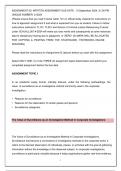ASSIGNMENT 02: WRITTEN ASSIGNMENT DUE DATE: 13 September 2024, 21:00 PM
UNIQUE NUMBER: 212224
(Please ensure that you read Tutorial Letter 101 on official study material for instructions on
how to approach assignment 2 and what is expected from you as student. Failure to follow
instructions outlined in TL101, TL301 and School of Criminal Justice Referencing Tutorial
Letter SCHJALL/301/4/2024 will make you lose marks and subsequently at some instances
lead to disciplinary hearing due to plagiarism. A “ZERO” (0) MARK WILL BE ALLOCATED
FOR COPYING & PASTING FROM THE STUDYGUIDE, TEXTBOOKS, ONLINE
SOURCES)
Please read the instructions for Assignment 02 (above) before you start with this assignment.
Select ONLY ONE (1) of the THREE (3) assignment topics listed below and submit your
completed assignment before the due date.
ASSIGNMENT TOPIC 1
In an academic essay format, critically discuss, under the following subheadings, the
value of surveillance as an investigative method commonly used in the corporate
investigation.
• Reasons for surveillance
• Reasons for the observation of certain places and persons
• Surveillance categories.
The Value of Surveillance as an Investigative Method in Corporate Investigations
The Value of Surveillance as an Investigative Method in Corporate Investigations
Surveillance has become a cornerstone of investigative methods in the corporate world. It
refers to the discreet observation of individuals, places, or activities with the goal of gathering
information without the knowledge of the observed subject. In corporate investigations,
surveillance is particularly valuable because it helps organizations gather real-time evidence,
1
, prevent potential misconduct, and protect company assets. The two primary forms of
surveillance, physical and electronic, offer distinct advantages in monitoring employee
behavior, identifying fraud, and addressing security concerns. I will critically explore the value
of surveillance by discussing the reasons for its use, the rationale behind observing certain
places and individuals, and the main categories of surveillance used in corporate
investigations.
There are various reasons why corporations opt for surveillance during investigations, and
these reasons often stem from the limitations of traditional investigative methods. According to
Newburn, Williamson, and Wright (2008:428), one of the primary reasons for initiating
surveillance is when other conventional methods have failed to yield sufficient evidence. For
instance, interviews and document reviews may not uncover crucial details, making it
necessary to observe the subject directly. Surveillance can provide irrefutable visual or
auditory evidence that might otherwise be impossible to obtain through traditional investigative
methods.
Another key reason for surveillance is the shift toward proactive strategies in corporate
investigations. Organizations are increasingly moving away from reactive approaches that
address wrongdoing after the fact and are instead focusing on preventing illegal activities
before they occur (Newburn et al., 2008:428). Surveillance enables corporations to detect
suspicious behavior early, allowing them to intervene before significant harm is done to the
business. This proactive stance helps prevent losses and ensures the integrity of business
operations. Moreover, surveillance is often quicker than traditional methods. Investigators can
obtain concrete evidence without the need for extended interviews or legal processes, which
can delay resolution (Van Rooyen, 2001:98).
We see advancements in technology have made surveillance more efficient and cost-
effective. Information technologies, such as advanced cameras, GPS tracking, and
communication monitoring software, provide investigators with new tools to monitor activities
discreetly. These technological advancements have created opportunities to gather real-time
evidence that is admissible in legal proceedings. Such high-quality evidence can often be as
compelling as an admission of guilt, making surveillance a critical tool in corporate
investigations (Ferraro & Spain, 2006:120).
2




